Accessible, reliable and safe public transport system
EFFECTIVENESS INDICATORS
The PTA’s effectiveness in providing an accessible, reliable and safe public transport system is measured using the following key effectiveness indicators for:
- Use of public transport
- Accessible public transport
- Service reliability
- Level of overall customer satisfaction
- Customer perception of safety
- Level of notifiable safety incidents
1. USE OF PUBLIC TRANSPORT
The use of public transport is measured by comparing the annual number of passengers carried with the number of service kilometres. Service kilometres are kilometres operated on scheduled passenger services and exclude “non-productive running” i.e. travelling from the depot to commence a service trip, and travelling back after completing a service trip.
The measure indicates the extent to which services provided, as represented by the number of kilometres operated, are being utilised. An increasing trend in the indicator will generally signify that patronage is rising at a rate greater than the rate of increase in service kilometres operated and represents an improvement in effectiveness as well as an increase in the use of public transport.
This effectiveness indicator is applied to each mode of public transport. The indicator is based on total boardings on Transperth services and includes fare-paying boardings plus free travel and transfers. Transfers are boardings which occur either between services within the same mode or between modes during the specified free transfer time.
Transperth Bus Services
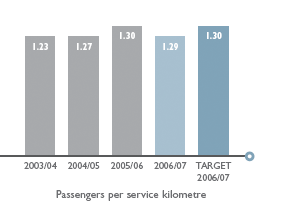
The result for 2006/07 was below the target for the year and lower than the 2005/06 result. The 2006/07 target was not achieved because while total boardings exceeded the target by 0.5%, service kilometres were 1.3% above target. The target of 1.30 was based on total boardings of 64.290 million and service kilometres of 49.298 million. The results for 2006/07 were total boardings 64.623 million and service kilometres 49.962 million, which resulted in average boardings of 1.29 for 2006/07.
Total boardings in 2006/07 recorded an increase of 1.1% compared to the 3.3% increase in 2005/06. The decline in the rate of increase in total boardings was due to a combination of factors:
- In the southern suburbs the loss of the Kwinana Freeway busway during 2006/07 adversely affected patronage in the Fremantle-Cockburn and Rockingham-Mandurah contract areas; and
- In the northern suburbs the availability of parking bays at the new train stations in Clarkson and Greenwood gave patrons the opportunity to travel by train without using feeder buses.
These negative trends were partly offset by the positive result in the Claremont and Belmont contract areas where route rationalisation and reduced journey times resulted in total boardings increasing by 4.8% in 2006/07 following an increase of 3% in 2005/06.
Increased traffic congestion and the lack of adequate bus priority measures on major roads resulting in non-competitive travel times were the main factors contributing to the reduction in the rate of growth in bus boardings in 2006/07 as compared to previous years.
Transperth Train Services
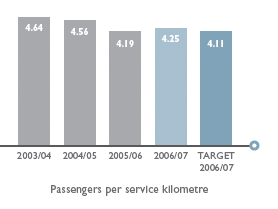
There was an improvement in 2006/07 result as compared to 2005/06.
The 2006/07 result was above the target set for the year due to total boardings and service kilometres exceeding target by 5.3% and 1.7% respectively.
Compared to 2005/06, total boardings increased by 4.8% following an increase of 4.5% in 2005/06. The rapid growth in patronage was due to:
- the expansion of the train fleet;
- the increasing use of three-car and six-car trains in 2006/07; and
- the availability of parking bays at the new train stations in Clarkson and Greenwood.
Regional Town Bus Services
In order to provide a more meaningful result in reporting the performance of regional town bus services, the effectiveness indicator for passengers per service kilometre has been separated into intra-town and inter-town components.
Intra-town services operate within rural town boundaries, while inter-town services run between regional centres.
a. Intra-Town Bus Services
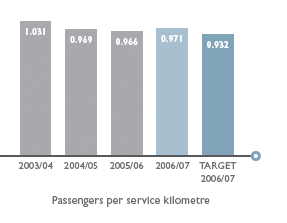
For regional intra-town services, the result for 2006/07 exceeded the target set for the year and improved on the previous year performance.
The increase in passengers per service kilometre for 2006/07 compared to target was mainly due to the strong performance of the services in Bunbury, Port Hedland, Albany, Carnarvon, Kalgoorlie, Collie, Esperance and Manjimup.
b. Inter-Town Bus Services
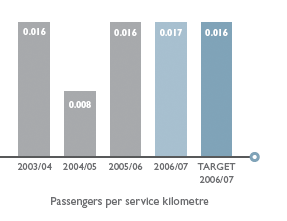
The 2006/07 result was slightly better than both the target set for 2006/07 and the previous year’s performance.
Transperth Ferry Services
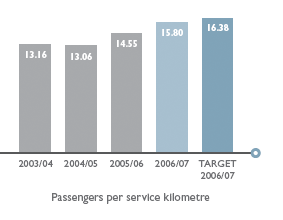
The 2006/07 result was below target. In setting the target the reduction in service kilometres following the termination of the Coode Street service in Como, was over-estimated and the reduction in patronage was under-estimated. The target assumed total boardings of 524,000, service kilometres of 32,000 and a target effectiveness indicator of 16.38. However, actual total boardings were 545,357 and service kilometres were 34,519 for 2006/07, resulting in the passenger per service kilometre of 15.80.
After a decline in patronage over four years since 2000/01, total boardings on the ferry service have increased with high rates of growth in 2005/06 (9.1%) and 2006/07 (8.5%).
While the ferry service has always been popular with tourists, the turn-around in patronage appears to be due to the increasing number of commuters from South Perth seeking the relative convenience of a fast ferry trip instead of the congested freeway.
Transwa Train Services
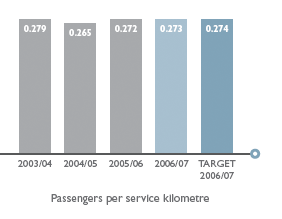
The 2006/07 result was slightly below target and slightly above the 2005/06 result.
Transwa Road Coach Services
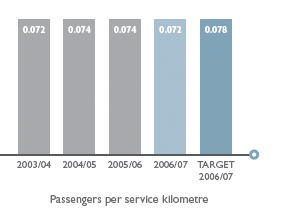
The result for 2006/07 was below target because of a lower patronage than estimated.



